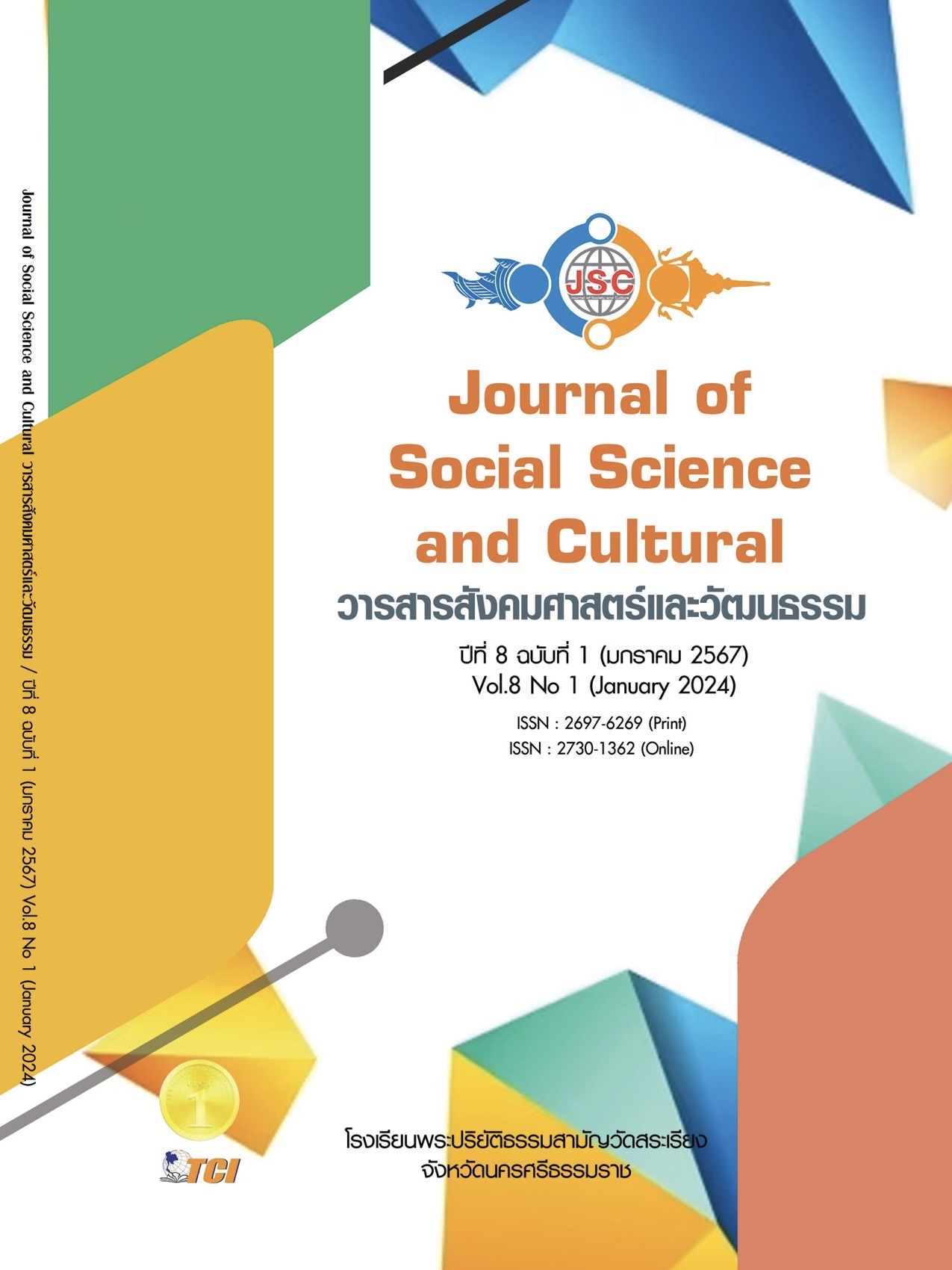BANGKOK TOURISM NETWORK COMMUNICATION FRAMEWORK DEVELOPED FROM THE PROTOTYPE OF THE ZURICH TOURISM NETWORK SWITZERLAND
Main Article Content
Abstract
This research aims to investigate: 1) The communication management patterns of the Zurich Tourism Network, Switzerland 2) The problems and communication management needs of the Bangkok tourism network 3) Develop a proposal for a communication management model for the Bangkok tourism network based on the model used in the Zurich Tourism Network, Switzerland. The research is qualitative in nature and involves in-depth interviews with two main groups of key informants: 1) leaders and experts in the Zurich tourism network, Switzerland; and 2) leaders and experts in the Bangkok tourism network. Data analysis is conducted by generating conclusions. The research findings: 1) The communication management pattern in Zurich Tourism network, Switzerland, can effectively establish and maintain network relationships. This is achieved through a network structure that links all components equally, guided by policies, missions, plans, and appropriate communication practices. Regular communication assessments ensure consistency. The network emphasizes principles of integrity and transparency, considering mutual benefits. 2) The problems and communication management needs of The Bangkok tourism network are characterized by a lack of clear policies, missions, plans, and communication practices. This results in an unsuitable communication environment, with a lack of alignment between organizational units. Communication assessments are error-prone, hindering the creation and maintenance of effective network relationships. 3) The proposal suggests that all sectors should collaboratively establish unified policies, missions, plans, and communication practices aligned with the context of tourism in Bangkok. This collaborative effort aims to create and maintain sustainable network relationships. The emphasis is on creating a network structure that promotes collaboration, ensuring long-term mutual cooperation among sectors. The main outcome is the PARTNER Communication model for tourism network management, consisting of seven components, aiming for maximum efficiency in networking for tourism, enhancing competitiveness, and adaptability for future use in other organizations.
Article Details
References
กระทรวงการท่องเที่ยวและกีฬา. (2563). 5 ขั้นตอนพลิกโฉมตัวเองพลิกโฉมประเทศไทย. เรียกใช้เมื่อ 26 มกราคม 2565 จาก https://www.mots.go.th
กระทรวงการท่องเที่ยวและกีฬา. (2564). แผนแม่บทภายใต้ยุทธศาสตร์ชาติ 20 ปี. เรียกใช้เมื่อ 26 มกราคม 2565 จาก https://www.mots.go.th
กาญจนา แก้วเทพ. (2557). เรื่องสื่อสาร การท่องเที่ยว. กรุงเทพมหานคร: ภาพพิมพ์.
เกรียงศักดิ์ เจริญวงศ์ศักดิ์. (2543). การคิดเชิงบูรณาการ. กรุงเทพมหานคร: พิมพลักษณ์.
ขวัญฤทัย สุริยะ และบวรสวรรค์ เจี่ยดำรง. (2564). การจัดการการสื่อสารเครือข่ายสุขภาพของสมาคมการแพทย์แผนไทยในจังหวัดจันทบุรี. วารสารวิทยาการจัดการและการสื่อสาร, 1(2), 57-90.
ณัฏฐินี ทองดี และคณะ. (2560). การยกระดับขีดความสามารถทางการแข่งขันและกลไกการจัดการตลาดการท่องเที่ยวโดยชุมชนแหล่งมรดกทางวัฒนธรรมลุ่มน้ำโขง ชี มูลในภาคตะวันออกเฉียงเหนือของประเทศไทย. วารสารวิจัยเพื่อการพัฒนาเชิงพื้นที่, 9(2), 122-137.
ณิชาภัทร สุรวัฒนานนท์. (2562). การท่องเที่ยวกับบทบาทขับเคลื่อนเศรษฐกิจไทย ฮีโร่จำเป็นหรือฮีโร่ตัวจริง. เรียกใช้เมื่อ 28 พฤศจิกายน 2563 จาก https://www.bot.or.th/ Thai/Rese archAn dPub lic ations/articles/Pages/Article_29Oct2019.aspx
เณริศา ชัยศุภมงคลลาภ และปาริชาต สถาปิตานนท์. (2556). รูปแบบการสื่อสารเพื่อการจัดการการท่องเที่ยวชุมชนตลาดน้ำยามเย็นอัมพวา. วารสารประชาสัมพันธ์และการโฆษณา, 3(2), 36-56.
บุษบา สุธีธร. (2560). การติดตามและประเมินผลโครงการการสื่อสารเพื่อการจัดการศึกษาโดยใช้พื้นที่เป็นฐาน. วารสารการประชาสัมพันธ์และการโฆษณา, 10(2), 1-14.
พรรัตน์ ทองเลิศ และปาริชาต สถาปิตานนท์. (2556). การสื่อสารในการจัดการการท่องเที่ยวของสถานีเกษตรหลวงอ่างขาง. วารสารประชาสัมพันธ์และการโฆษณา, 6(2), 72-87.
พัชรินทร์ รัตนวิภา และคณะ. (2566). การจัดการการสื่อสารเครือข่ายร่วมปฏิบัติงานของสำนักงาน กกต. วารสารสังคมศาสตร์และวัฒนธรรม, 7(1), 146-166.
วิทยาธร ท่อแก้ว. (2548). “การประยุกต์นิเทศศาสตร์ด้านการพัฒนาองค์การ”. ใน ประมวลสาระชุดวิชาการประยุกต์นิเทศศาสตร์เพื่อการพัฒนา หน่วยที่ 1 (หน้า 1-66). นนทบุรี: มหาวิทยาลัยสุโขทัยธรรมาธิราช บัณฑิตศึกษา สาขาวิชานิเทศศาสตร์.
ศุภลักษณ์ ศรีวิไลย และรุ่งเรือง ทองศรี. (2564). การแพร่ระบาดของโควิด 19 ส่งผลต่อการท่องเที่ยวของประเทศไทย. วารสารบริหารนิติบุคคลและบริหารท้องถิ่น, 7(8), 405-416.
สำนักงานคณะกรรมการพัฒนาการเศรษฐกิจและสังคมแห่งชาติ. (2562). ยุทธศาสตร์ชาติ 20 ปี (พ.ศ. 2561-2580). (พิมพ์ครั้งที่ 2). กรุงเทพมหานคร: สำนักงานเลขานุการของคณะกรรมการยุทธศาสตร์ชาติ สำนักงานคณะกรรมการพัฒนาการเศรษฐกิจและสังคมแห่งชาติ.
สำนักงานปลัดกระทรวงการท่องเที่ยวและกีฬา. (2562). สถิตินักท่องเที่ยวชาวต่างชาติที่เข้ามาประเทศไทย 2552 - 2561. เรียกใช้เมื่อ 17 มกราคม 2563 จาก http://statbbi.nso.go.th/st aticreport/page/sector /th/17.aspx
สุรพงษ์ โสธนะเสถียร และวัลลีย์ ศรีประภาภรณ์. (2553). การจัดการทางการสื่อสารในคณะแพทย์ศาสตร์ศิริราชพยาบาล. เวชบันทึกศิริราช, 3(1), 31-39.
สุรพงษ์ โสธนะเสถียร และสถาพร สายเชื้อ. (2549). การสื่อสารเพื่อการจัดการในองค์การธุรกิจ. ใน รายงานการวิจัย. สำนักงานกองทุนสนับสนุนการวิจัย.
เสนาะ ติเยาว์. (2538). การสื่อสารในองค์การ. กรุงเทพมหานคร: มหาวิทยาลัยธรรมศาสตร์.
อนวัช มีเคลือบ และคณะ. (2560). การจัดการการสื่อสารเพื่อพัฒนาความผูกพันศิษย์เก่าของมหาวิทยาลัยรัฐในประเทศไทย. วารสารบริหารธุรกิจ เศรษฐศาสตร์และการสื่อสาร, 12(1), 163-177.
อรรถพล ยุสุวพันธ์. (2564). การจัดการการสื่อสารเพื่อส่งเสริมการท่องเที่ยวของเทศบาลเมืองสตูล. วารสารวิจัยและพัฒนา มหาวิทยาลัยราชภัฏสวนสุนันทา, 13(2), 320-335.
APAC Snow Brand Study. (2019). Asia-Pacific (APAC) Snow Brand Study 2019. Retrieved October 24 , 2021 , from https://www.clubmed.com.sg/l/press-room/apac-snow-survey-2019
Business Traveler Asia Pacific. (2022). Business Traveller Asia-Pacific Awards 2022 results. Retrieved March 4, 2023, from https://www.businesstraveller.com/awards/business-traveller-asia-pacific-awards-2022-results/
Daiva Labanauskaie.et al. (2020). Use of E-marketing tools as communication management in the tourism industry. Tourism Management Perspectives, 34(2020), 1-8.
Mile & Huberman. (1994). An expanded sourcebook qualitative data analysis (2ed.). Thousand Oaks, CA: Sage.
Srisawa, T. (2021). IMD World Competitiveness Yearbook 2022. Bangkok: Bangkok.
StrAh Ursula & Jaatinen Miia. (2002). New approaches to communication management for transformation and change in organisations. Journal of Communication Management, 6(2), 148 – 165.
Tanakorn. (2021). Keep an eye on the outstanding features of Switzerland. Amidst the COVID-19 crisis. Retrieved July 24 , 2021, from https://globthailand.com/switzerland-251021/
World Economic Forum. (2021). Travel & Tourism Competitiveness Index Report. Retrieved June 5 , 2021, from https://reports.weforum.org/
Zurich Tourism. (2023). About Us. Retrieved April 2 , 2023, from https://zt.zuerich.com/en


